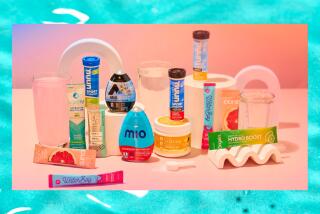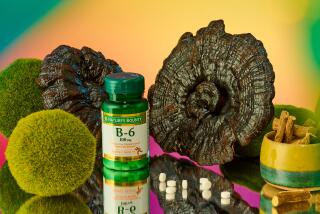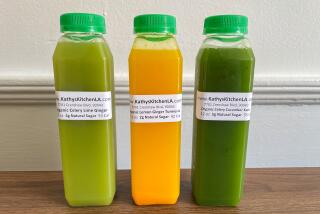A closer look at energy drinks with a natural kick
Energy drinks — sugary, caffeinated beverages that are supposed to provide a quick pick-me-up — have been taking some hits lately.
The natural food industry has responded with a flurry of alternatives, including replacing high-fructose corn syrup with organic evaporated cane juice and agave, sucralose with stevia, synthetic caffeine with yerba mate. Add South American “super foods” and vitamins, and you’ve got a new category of energy drinks.
Names such as Pur Pak, Youth H20 and Altar Herbal Martini convey a tamer and more healthful approach than, say, Monster, Red Bull or Killer Buzz.
But how different, and how beneficial, are these beverages?
Consumers need to watch the caffeine and sugar levels in these drinks too, medical professionals say, even if those ingredients are organic and derived from natural sources. And though drinking something that contains vitamins, acai and ginseng might be preferable to downing a can of liquid laden with high-fructose corn syrup, artificial coloring and preservatives, the effect on the body remains questionable.
“There is not a lot of evidence that these drinks have the benefits they are supposed to,” said John Higgins, an associate professor of medicine at the University of Texas Health Science Center at Houston. “They are supposed to increase energy levels and even boost memory. But I’ve looked at many of these ingredients, and they have not shown that they do what they are supposed to do.”
An infusion of vitamins in a drink, for example, might not do much, he said. “A lot of the vitamins just go out in the urine, and we don’t know if they truly help,” Higgins said. “Sometimes all you need is a power nap.”
Nutritional biochemist Shawn Talbott, who is based in Salt Lake City, suggested looking for drinks with sugars such as brown rice syrup or maltodextrin that hit the bloodstream more slowly, rather than those that are absorbed quickly, such as glucose.
“On the caffeine side, most energy drinks use pure caffeine, which is absorbed very quickly into the bloodstream and generates a hit of energy,” Talbott said. “With the ‘slower’ forms, like green tea, yerba mate, kola nut and guarana, the caffeine is bound with fiber, flavonoids and other plant constituents.”
That means a slower rate of absorption, he said. “It is not a healthy approach — but it is a healthier one. What people are looking for is a little pick-me-up through the day, and sometimes the best thing is an actual cup of coffee or tea.”
Here’s a look at some of the popular ingredients in the newer energy drinks:
Vitamin B12
What it does: A deficiency has been linked to fatigue, weakness and poor memory. Drinks that contain it help convert carbohydrates into glucose in the body, fighting off lethargy.
Where to find it: Pur Pak, individual sachets of powder that mix with water contain B12 as a key ingredient alongside other vitamins and minerals; eboost Superberry Liquid Shot combines B12 with green tea and green coffee; Bodyworks Energy Shot, which along with B12 contains caffeine and gingko biloba leaf.
Yerba mate
What it does: Popular in South America, the leaves of the yerba mate plant contain caffeine.
Where to find it: Pyure Brands Organic Energy Optimization (OEO), a 2-ounce shot that includes yerba mate and green tea; Guayaki Yerba Mate Energy Shot, a lemon-flavored concoction that also contains ginger and goji berries; Sambazon Energy, with yerba mate and acai berry.
Ginseng
What it does: Common in traditional medicine in Asia, ginseng is said to have healing properties, including lowering blood pressure and stimulating energy.
Where to find it: Vitamin Squeeze Energy Bursts with flavors such as black cherry and blood orange contain 60 milligrams of caffeine — the same as an 8-ounce cup of coffee — which is derived from ginseng, tea extracts and gingko biloba; Lights On, made by Dynamaxx, has Siberian ginseng alongside caffeine-rich plants like guarana; Altar Herbal Martini, which makes artisanal herbal tonics for consumption alone or for cocktails, has chi, a beverage with ginseng, green tea and kola nut.
Children and energy drinks don’t mix, says pediatrics group
The caffeine and other stimulants in energy drinks, the American Academy of Pediatrics said, “have no place in the diet of children and adolescents.”
The academy issued its position in 2011 after what it called a “rigorous” review of the medical literature, because consumption of energy and sports drinks was “widespread” among young people. It found that the stimulants in energy drinks include caffeine, guarana, taurine, ginseng and L-carnitine. The drinks typically also contain carbohydrates, protein, vitamins, sodium and other minerals.
Caffeine has been shown to enhance physical performance in adults, the academy said in its report, but it also noted that “dietary intake should be discourage for all children.” The primary source of caffeine for children is soft drinks, and some cans or bottles of energy drinks can contain more than 500 milligrams of caffeine — the equivalent of about 14 cans of soda, the academy said.
— Mary MacVean
ALSO:
High-tech products to improve your health
Dieter, beware: Weight-loss fads can be bad for your health
Why fall pollen allergy season knows few bounds in California
More to Read
Eat your way across L.A.
Get our weekly Tasting Notes newsletter for reviews, news and more.
You may occasionally receive promotional content from the Los Angeles Times.










